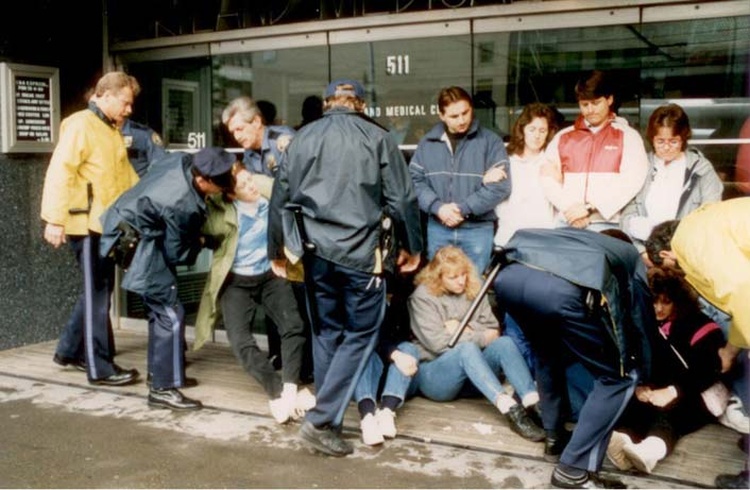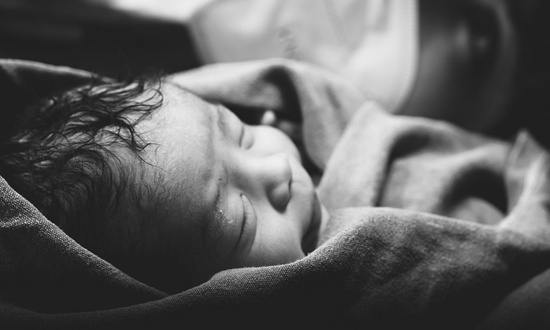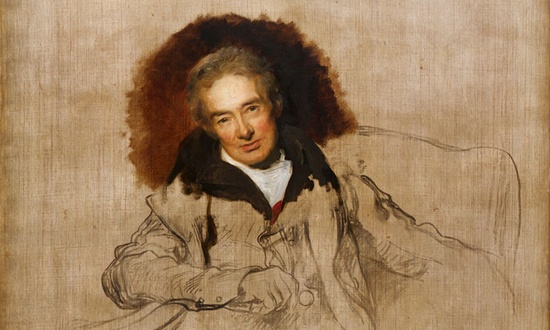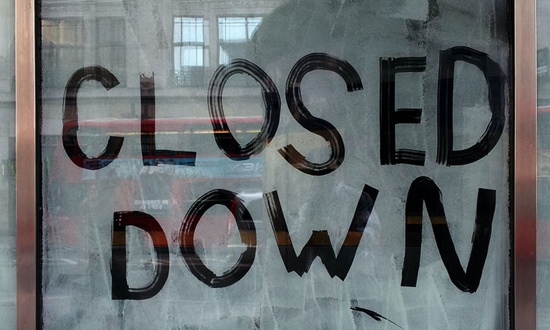In her recent article for The Gospel Coalition, “Why There Are Way More Pro-Life Protesters Than You Think,” Sarah Eekhoff Zylstra wrote about how the prolife movement has grown and changed over the years, starting back in the late 1980s with rescuing, which I, John Piper, and many others were a part of. (In fact, Piper and I “met” over the phone after we had both rescued for the first time on the same day, he in Minneapolis and I in Portland. We talked about the impact of rescuing on the churches where we were pastors.)
Warning: this blog is about twice as long as usual, because it’s more of an essay and commentary designed to give insight into a movement that played a big role in churches and was actually the reason that my life took the direction it did, starting with the founding of Eternal Perspective Ministries. That happened in 1990 when I had to resign as a pastor due to the lawsuits from abortion clinics. I don’t want to do this in two parts, so here it all is. I hope you find it interesting and helpful.
Sarah interviewed me and I suggested others for her to contact about our involvement in civil disobedience on behalf of unborn children, including our friends Kathy and Ron Norquist. She also quoted from Liberty University English professor Karen Swallow Prior, who was involved with rescues in the early 90s across the country from us, in New York.
It is, admittedly, difficult for many people in 2020 to understand our actions then, as there is much that has been lost in translation or misunderstood over the past thirty years (indeed, our involvement was greatly misunderstood by many even back in the day, e.g. prominent evangelical pastors declared our actions as violating Scripture). I hope the following will provide some further clarification for those who wonder, “What exactly did you do, and why were you compelled to do it?” and “Was it worth it, and if so, why doesn’t rescuing happen now?”
What We Did
Rescuing was a peaceful, nonviolent, and united action in which people placed their bodies in front of the entrances of an abortion clinic. The purpose was to prevent access to the clinic and thereby to save the lives of unborn children who would otherwise be killed shortly after their mothers entered the building. (In the photo above, from The Gospel Coalition article, I’m in the back row, second from the right.)
We never shouted at or spoke harshly to the women who came for abortions. In fact, we signed a pledge card in which we promised not to raise our voices. The most central and basic components of our rescues were praying and singing.
Most, though unfortunately not all, rescue groups gave careful attention to developing standards of behavior. The group I rescued with had printed guidelines which were reviewed carefully before a rescue and enforced during it. Among them were these:
Please don’t talk with or shout at the police, passers-by, abortion-mill personnel or anyone else. Violators will be asked to leave if it becomes a problem.
Always walk, do not run. Ignore hecklers.
Do not lock arms or hold on to each other if police are arresting. Never block access to police.
We are not at war with the police, abortionists, escorts or hecklers. All our actions go back to the primary goal of saving babies’ lives and mothers from being exploited. We must keep focused on our goal of serving the Lord. This is not the place to enact any “personal agenda” one may have.
In addition, before participating in a rescue with this group, every person was required to sign the following pledge:
I pledge to be Christlike in my behavior and to cooperate with the leaders, spirit and goals set forth by Advocates for Life. I will remain peaceful and nonviolent in word and deed during all the activities associated with the rescue. Having prayerfully considered this pledge, I sign it with the determination to fulfill it as an obligation before God.
Why We Did It
The most critical premise behind rescuing was that the unborn is a human child, created in the image of God, as valuable in the sight of God as any born person. By the time their mothers reached the abortion clinic, the unborn were within minutes of being torn to pieces. We believed that physically preventing entrance to the clinic was the only remaining nonviolent avenue to save the child’s life. By that time, there was nothing more that could be done by the prolife educational and political organizations (which I worked with and supported) or the pregnancy centers (which I loved—I served on the board of the first one in the Pacific Northwest) to save these children’s lives.
Of course, mothers denied entrance still had the option of rescheduling an appointment at another time, at the same clinic or a different one. But the rescue accomplished several vital things. First and foremost, it bought time for the unborn child. The child didn’t die that day. Second, there was a good chance the child would not die at all. The mother might decide not to have an abortion, or to indefinitely delay rescheduling an abortion.
One abortionist complained that when a rescue occurred at his clinic, 20 to 25 percent of the women canceled their appointments and never came back. Years ago Planned Parenthood stated that 20 percent of women who missed their initial appointment for an abortion, regardless of the reason, did not come back to any clinic, and did not end up getting an abortion at all. That was one of their arguments against rescuing, and of course it became one of our arguments for it.
While the main goal of rescuing was to obey God by saving lives about to be killed, rescuing had secondary objectives as well. These included identifying with the victims, making the public aware of the holocaust, appealing to the conscience of society, and eventually effecting change in the laws. Our actions also appealed to the consciences of abortion clinic staff. In some cases, people were delivered from the darkness of child-killing through the influence of rescues.
In her article, Sarah quoted Karen Swallow Prior, who expressed this well: “I don’t look back with regret at all or think I wouldn’t do it over…. Some things mitigate or make that different now, but still—it was the right thing to do. We were not only preventing abortions, but we were also raising consciousness about abortion.”
The decision to rescue was difficult and the personal costs were sometimes great. But I and others were compelled by God’s Word: “Rescue from death those being led to slaughter” (Proverbs 24:11). And, “Speak up for those who cannot speak for themselves . . . defend the rights of the poor and needy” (Proverbs 31:8–9, NIV). The theme of intervening on behalf of the weak and vulnerable, of protecting the helpless from the abuses of others, is central to literally hundreds of passages, and is one of the most dominant themes in the entire Bible.
I asked myself if I really believed these unborn children were human beings, mercilessly slaughtered in my own city every day. If so, why wasn’t I doing what I told myself I would be doing if they were older and bigger people as in Nazi Germany? Abortion was killing innocent people. Why wasn’t I doing for them what I would do for other innocent people killed in other ways?
Sarah quoted my good friend and brother Ron Norquist in her article:
“Before rescues, there was the idea of the humanity of the unborn,” he said. “The one thing the rescues did was solidify the fact—these are actual human beings being led to slaughter. Proverbs 24:11 says to rescue them.”
Norquist, who was an insurance agent at the time, “didn’t really know what Jesus would do, because he didn’t have that situation. But I thought there was enough in Scripture that we should at least do something nonviolent with our own body, like you would if they were taking two-year-olds in there.”
As I wrote in my book Is Rescuing Right, I couldn’t escape either the biblical or historical examples of believers breaking the law to save lives. I was touched deeply by Pastor Dietrich Bonhoeffer’s courage, publicly criticizing Hitler and calling upon the German church to stand up for the Jews. (In fact, though he was a lifelong advocate of peaceful actions in the name of Jesus, he was ultimately hung by the Nazis because of his involvement in a plot to assassinate Adolph Hitler.) Francis Schaeffer’s call to defend the unborn affected me profoundly. (See this article for a longer summary of Scriptural and historical perspectives on rescuing and civil disobedience. If you have time and are interested in reading more, here is the text of closing arguments I prepared for the court case in which a group of prolifers and I were ultimately found guilty.)
One important clarification: civil disobedience is not revolution. Revolution is violent and sweeping in its implications; civil disobedience is the breaking of a specific law in a context of general respect for the law. Rescuing acknowledged the purpose and legitimacy of government. It was not clandestine. It was not violent. Compassion for the victim, not hatred for the victimizer, motivated us.
Suppose you heard that I drove a car ninety miles an hour down a freeway. Was I right or wrong? I was wrong, of course. After all, I broke the law. If you heard that a policeman had pulled me over and cited me you’d say, “Fine, he deserved it.”
But suppose you found out later that lying in the back of the car was my young daughter, who had a ruptured appendix. She could have died any minute, and I broke the law in an attempt to get her to the doctor to save her life. Would this additional factor affect your opinion about whether my action was right or wrong? Of course it would. As long as you focus on the law, on the speed limit, on why Christians must always obey such laws, you will condemn my action. But when you remember the little child in the back seat, it changes everything. The child about to die makes all the difference.
Was It Worth It?
Between May 1988 and May 1989 Operation Rescue, a national organization founded by Randall Terry, documented 224 cases of babies whose lives were definitely saved through rescues. This does not include lives saved in rescues unaffiliated with Operation Rescue, or the many situations impossible to follow up and document. The total number for that one-year period was almost certainly in the thousands, but even if “only” in the hundreds, isn’t that still significant?
On a busy Saturday in our area there was one clinic that could do forty abortions. If a rescue closed the clinic for the day and 20 percent didn’t reschedule an abortion there or elsewhere (using Planned Parenthood’s figures), then that was eight lives saved. If the clinic was closed only half the day, then maybe it was four lives saved. If it was a smaller clinic or we were arrested early, maybe it was “only” two lives saved.
Multiply that by six or twelve or twenty rescues a year in one area, then multiply again by over a hundred other places in the country where rescues were being regularly done. The number saved may still have been small compared to the number killed, but what kind of price tag do we put on a few thousand children, a few hundred, or even a dozen?
One time a woman from my church told me she’d scheduled an abortion, then the night before she saw us on the news, blocking doors at the clinic, and also saw me standing there reading from a Bible. As a result God spoke to her heart, and after thinking it through decided to have her baby. I would see her and her child or other family from time to time even years later.
When I was involved with rescuing, I met a young couple with a beautiful baby in their arms. Some months earlier they’d come for an abortion. They listened to a sidewalk counselor. They’d decided to let their baby live. And through the contact with Christians they’d come to a saving knowledge of Christ. Not only is the baby alive—she’s growing up in a Christian home. I remember thinking, “If being part of this makes me a fanatic, it’s a label I’m willing to bear!”
The year and a half that I participated in rescuing brought many difficulties, including multiple arrests, a night in jail, and ultimately the $8.2 million judgment against me and a group of prolifers. However, in the midst of these difficulties my family and I deeply sensed the presence and approval of our Lord Jesus. He faithfully walked ahead of and beside us. We experienced peace and joy. These transcended every difficult circumstance that came out of our choice to rescue the unborn.
What Changed, and the Prolife Movement Today
As Sarah shared in her article, the negative media coverage and the legal consequences of rescuing became much greater as the movement continued:
From 1977 to 1989, more than 24,000 prolife protesters were arrested at abortion clinics.
The high number of arrests continued into the ’90s, then dropped off abruptly: In 1993, there were 1,236 arrests. In 1994, 217. In 1995, 54. By 2000, there were none.
“There were two serious obstacles that shut down sit-ins or diminished their effectiveness, and pushed protesters in a different direction,” Americans United for Life (AUL) attorney Clarke Forsythe told TGC. One was the media coverage, which “did not favor” the demonstrators. The other was the threat of legal prosecution, which culminated in the passage of the Federal Access to Clinic Entrances Act, signed into law by President Bill Clinton in 1994.
But God was at work even in this. As Sarah explained, this opposition helped the prolife movement find new strategies and even grow explosively. When rescuing gained public attention in 1987 and 1988, through the large Operation Rescue interventions, this served to rejuvenate a sagging prolife movement. Even those prolife organizations that were not supportive of rescuing benefited from the renewed interest in saving unborn children.
Today, thousands of prolife organizations around the country and throughout the world provide free pregnancy tests, ultrasounds, counseling, support groups, childcare classes, financial management education, babysitting, diapers, children’s clothes, and housing. Most of these centers have dozens of volunteers, some of them hundreds, donating not only time spent with clients, but also everything from clothing to maintenance to service to office supplies and computer support. I served on the board of one such center, on the steering committee to get another started, and have spoken at dozens of them across the country. Though their services cost them a great deal of money—as opposed to making them a great deal of money—there are many more pregnancy resource centers in the United States than there are abortion clinics. (See this excellent article.)
Add to these tens of thousands of churches donating time, money, food, house repairs, and every other kind of help to needy pregnant women, single mothers, and low-income families. Countless prolifers adopt children, open their homes, and volunteer to help children after they’re born. I’ve seen a wide variety of prolife ministries close-up. In nearly every case I’ve walked away impressed with the difference they’re making. Together these efforts comprise the single largest grassroots volunteer movement in history.
In addition, there are still prolifers who go to clinics to pray and act as sidewalk advocates to women who come to get abortions. Except where court injunctions have created no-access zones in front of clinics, sidewalk counseling is perfectly legal. In fact, advocates can stand on the perimeter of the forbidden zones and still talk to most of the abortion-bound mothers. They are not arrested, prosecuted, jailed, or sued. Others can join them, holding signs that offer help and support. God has used these efforts to save unborn children and help women. (See this article by Kathy Norquist and Sidewalk Advocates for Life for more information.)
For a variety of reasons, it has been thirty years since I last engaged in civil disobedience. But I believe God called me to that one method for a period of time, just as He called me to work with pregnancy centers years before that. Now our ministry gives substantial funds to support the prolife cause. I still speak up for the unborn in messages, writings, and personal conversations. This will always be a cause close to my heart, because I believe it is close to God’s heart.
Overall, the prolife cause has grown and gained greater visibility in the last three decades. Sarah shared these encouraging statistics in her article:
In 2015, the number of protesters reported by abortion clinics rose dramatically from where it had hovered since the mid-’90s (usually between 5,000 to 10,000 a year), to more than 20,000. The next year, it was more than 60,000. The next year, 78,000.
Last summer, the National Abortion Federation (NAF) said the number of protesters reported by abortion clinics exceeded 99,000 in 2018—the most, by far, ever seen in the United States.
She also writes:
It’s hard to say what’s working—the pro-life legislation, the presence of protesters, the availability of pregnancy centers, the improving ultrasound technology, the destigmatizing of single motherhood, or increased access to birth control—but something is. In 2017, abortions dropped to the lowest rate since Roe v. Wade.
“That blows my mind every single time I think of it,” Americans United for Life president Catherine Glenn Foster said. “We are making incredible progress.”
Even in this world I’m optimistic about the opportunity to impact and influence all kinds of people. I’ve seen joy and peace in the lives of many women who’ve had an experience of forgiveness after their abortions and many women who, as a result of intervention, spared the lives of their children.
Someone told me about a woman on her way to have an abortion. She got behind a car with a prolife bumper sticker. What happened next? She turned around, canceled her appointment, and had the baby. If God can use even a bumper sticker to save two lives—a baby from death and a mother from great harm—how might He use even your own modest efforts? One of our dearest friends, who suffered much from abortions, came to faith in Jesus when she lived with us as a pregnant teenager (you can read her testimony here). We were with her 33 years later when she met the boy she had placed for adoption. How can you put a price on that?
Every time the lies of Satan the child-killer are exposed—each time a mind is changed, a life is saved, and a woman is spared the horrors of abortion—God is glorified and a great battle has been won. Great stories of what we never saw in this life await us in eternity whenever we heed those words of our God that bear repeating here:
Rescue from death those being led to slaughter. (Proverbs 24:11)
Speak up for those who cannot speak for themselves,
for the rights of all who are destitute.
Speak up and judge fairly;
defend the rights of the poor and needy. (Proverbs 31:8–9)Browse more prolife articles and resources, as well as see Randy's books Pro-Choice or Pro-Life: Examining 15 Pro-Choice Claims, Why ProLife? and ProLife Answers to ProChoice Arguments.




